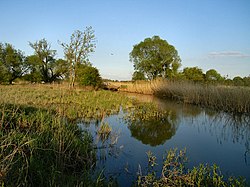River in Germany
.mw-parser-output .hidden-begin{box-sizing:border-box;width:100%;padding:5px;border:none;font-size:95%}.mw-parser-output .hidden-title{font-weight:bold;line-height:1.6;text-align:left}.mw-parser-output .hidden-content{text-align:left}You can help expand this article with text translated from
the corresponding article in German. (October 2011) Click [show] for important translation instructions.
View a machine-translated version of the German article.
Machine translation, like
DeepL or
Google Translate, is a useful starting point for translations, but translators must revise errors as necessary and confirm that the translation is accurate, rather than simply copy-pasting machine-translated text into the English Wikipedia.
Do not translate text that appears unreliable or low-quality. If possible, verify the text with references provided in the foreign-language article.
You must provide
copyright attribution in the
edit summary accompanying your translation by providing an
interlanguage link to the source of your translation. A model attribution edit summary is Content in this edit is translated from the existing German Wikipedia article at [[:de:Pelze]]; see its history for attribution.
You should also add the template ((Translated|de|Pelze)) to the
talk page.
For more guidance, see
Wikipedia:Translation.
The Pelze river is a tributary of the Mulde in the Middle Elbe Biosphere Reserve near the confluence into the Elbe, between Dessau and Roßlau.
The watercourse has a length of about 1.5 km and is connected to the Leiner See and Löbben through the flow channel. Lakes are fed by the Kapengraben into the Mulde. During high water levels in the Mulde and Elbe, the Pelze also comes into contact with the Igel-Lache, another old riverbed.
With 21 documented species, the Pelze is considered the most species-rich old riverbed in the nature reserve.[1] In 1927, the Pelze was designated as one of the first protected areas for a mammal in Germany, specifically as a beaver reserve for the European beaver.[2]
At the angle formed by the confluence of the Pelze with the Mulde, in the 12th century, there was the castle "Burg Waldeser" and a village of the same name.[3]
